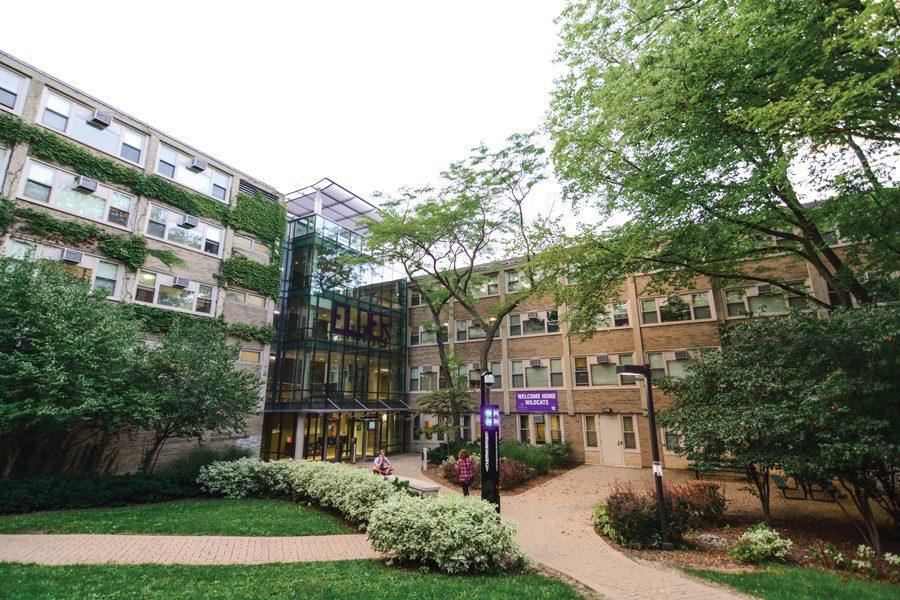Modified quarantines implemented in Sargent, Elder after uptick in COVID-19 cases
Jeffrey Wang/Daily Senior Staffer
Elder Residential Hall at 2400 Sheridan Rd. After an increase in COVID-19 cases, Sargent Hall and Elder Residential Hall issued a stay at home order to Northwestern students.
March 4, 2021
Residents of two residential halls have undergone an in-dorm stay-at-home period following local outbreaks in each building.
On Feb. 22, Communication freshman Amy Reyes-Gomez received an email from residential services declaring a five-day “Stay at Home Order” effective immediately for the entire second floor of Sargent Residential Hall. On Feb 25, a similar email was sent to first floor residents of Elder Hall.
The emails said no student should leave their room outside of essential activities such as using the restroom, picking up dining hall meals, and getting tested for COVID-19. It also instructed students to get rapid antigen tests three-to-four times over the course of the stay-at-home period.
“It definitely wasn’t surprising to me,” Reyes-Gomez said. “There’s definitely a large group of people on the floor that were being irresponsible.”
Reyes-Gomez said around ten students from her floor out of a total of 30-40 went into quarantine housing as part of University contact tracing procedures. To her, this number “made sense” given the close proximity the students shared with others living on their floor.
The restrictions for Sargent were lifted Saturday while the restrictions for Elder were lifted on Wednesday.
The University’s Chief Risk and Compliance Officer Luke Figora told the Daily that in-dorm stay-at-home orders were not a result of community transmission, but rather because of a rise in positive cases within particular friend groups or “pods” that have formed within the dorms.
“We’ve set thresholds to say, ‘Let’s pause and make sure that we don’t have some kind of spread within the facility,’” Figora said. “‘Let’s make sure that your bathrooms or in person activity, whatever it might be, might not be contributing to (the spread of COVID-19).’”
Medill freshman Mya Franklin, a third-floor resident living in Elder, said she received an email saying Residential Services is “monitoring a heightened COVID positivity rate in Elder Hall” and that she was no longer allowed to visit her friends living on the first floor, where the outbreak was happening.
For Franklin, the email came as a “complete shock” and she said she wished the University was more consistent in its communication. Only the first-floor residents received the email with the details of the stay at home order, which led to some confusion, Franklin said.
“There’s been zero contact with us besides that initial email, and it’s confusing whether or not we are in quarantine or not. We’re kind of in a limbo,” Franklin said.
Gaps in communication have been an issue not just for students, but for faculty living in on-campus housing as well. Weinberg Prof. Elizabeth Lenaghan, the faculty-in-residence for Elder Hall, said she would prefer more frequent communication from the University.
Lenaghan, who had been organizing socially distant walks with students living in Elder, said students didn’t feel they knew what was happening. She, too, was only provided with the emails sent to the students.
In a statement to the Daily, Carlos M. Gonzalez, executive director of Residential Services, said the information was not sent to students outside of the affected dorms due to privacy concerns and because “the content is most relevant to the residents of the impacted community.”
Though she acknowledged the concerns about student privacy, Lenaghan referenced the University’s online COVID-19 dashboard, and said for transparency reasons, differentiating the number of cases on and off campus would be especially helpful.
Reyes-Gomez said it was difficult to not know the exact number of cases on her floor throughout the stay-at-home period.
“The university as a whole could be much more transparent,” Lenaghan said. “I think that the COVID tracker doesn’t get updated frequently enough, and that the information that it provides is less than (what) we see from lots of other peer institutions.”
Despite the restrictions, both Franklin and Reyez-Gomez are worried about a lack of adherence to the University’s guidelines. Franklin said Northwestern tends to rely on community adherence with their COVID-19 rules, and she believes people are still going out even after the email was sent.
“There was nothing holding us to (the guidelines),” Reyes-Gomez said. “It was purely an honor system, nothing was going to stop us from leaving.”
Sneha Dey contributed reporting.
Email: anushuyathapa2023@u.northwestern.edu
Related Stories:
— Northwestern temporarily halts Color COVID-19 testing, students must test twice a week
— Northwestern opens five new satellite COVID-19 testing sites



